The courses listed below, taught at University of Texas at Austin, are grouped in the following categories:
- Core Acoustics Courses in Cockrell School of Engineering
- Acoustics-Related Courses in Cockrell School of Engineering
- Seismo-Acoustics Courses in Jackson School of Geosciences
- Hearing and Speech Science Courses in College of Communication
- Electronic Music Courses in College of Fine Arts
All courses are graduate level except for the few that are identified as undergraduate level. Consult the graduate and undergraduate catalogs for additional information on course offerings. See also the programs of study in acoustics and related fields at the University.
The Art Institute of Austin, not affiliated with University of Texas, offers courses in audio engineering leading to a Bachelor of Science in Audio Production.
Core Acoustics Courses in
Cockrell School of Engineering
The first six courses are offered every year, the next five in alternate years. Acoustics Seminar, appearing last in this list, is offered every fall and spring semester.
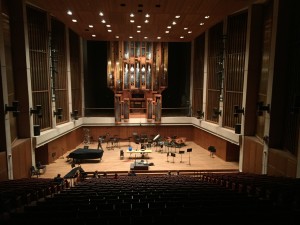
Bates Recital Hall on UT Campus
ME 355K: Engineering Vibrations (Undergraduate). Time-domain and frequency-domain analysis of vibrating systems; matrix methods, instrumentation, and vibration control; numerical methods. Offered every year.
EE 363N/ME 379N: Engineering Acoustics (Undergraduate). Principles of acoustics, with applications drawn from audio engineering, biomedical ultrasound, industrial acoustics, noise control, room acoustics, and underwater sound. Offered every year.
AET 339/ME 379Q: Musical Acoustics (Undergraduate). Designed for music and liberal arts majors to learn about the science of sound and how musical instruments work. Other topics include principles of musical scales, hearing, architectural acoustics, and electronic music. May not be counted toward a degree in the Cockrell School of Engineering. Offered in alternate years.
EE/ME 384N-1: Acoustics I. Plane waves in fluids; transient and steady-state reflection and transmission; lumped elements; refraction; strings, membranes, and rooms; horns; ray acoustics; absorption and dispersion. Offered every year.
EE/ME 384N-2: Acoustics II. Spherical and cylindrical waves; radiation and scattering; multipole expansions; Green’s functions; waveguides; sound beams; Fourier acoustics; Kirchhoff theory of diffraction; arrays. Offered every year.
EE/ME 384N-3: Electromechanical Transducers. Modeling, analysis and design of transducers for reception and transmission of acoustic and vibration signals; dynamics of coupled electrical, mechanical and acoustical systems; effects of transducer characteristics on fidelity and efficiency of transduction. Offered every year.
EE/ME 384N-4: Nonlinear Acoustics. Waveform distortion and shock formation; harmonic generation and spectral interactions; effects of absorption and dispersion; parametric arrays; Rankine-Hugoniot relations; weak shock theory; numerical modeling; radiation pressure; acoustic streaming. Offered in alternate years.
EE/ME 384N-5: Underwater Acoustics. Acoustic properties of the ocean; acoustic propagation, reflection, reverberation, scattering and target strength; ocean noise; introduction to array and signal processing; basics of sonar design. Offered in alternate years.
EE/ME 384N-6: Architectural Acoustics. Human perception of sound; principles of room acoustics; sound-absorptive materials; transmission between rooms; acoustical design of enclosed spaces. Offered in alternate years.
EE/ME 384N-7: Ultrasonics. Acoustic wave propagation in fluids, elastic solids, and tissue; transducers, arrays, and beamforming; nondestructive evaluation; acoustical imaging. Offered in alternate years.
EE/ME 384N-8: Wave Phenomena. Fourier acoustics and angular spectra; nearfield acoustical holography; Fraunhofer, Fresnel, and parabolic approximations; sound beams; Green’s functions; Born approximation; propagation and scattering in moving, periodic, and random media. Offered in alternate years.
EE/ME 384N-9: Acoustic Metamaterials. Wave propagation in heterogeneous media displaying nonclassical effective properties; introduction to effective medium theories including fundamental limits on effective properties, transmission and scattering matrices, waves in periodic media, localized resonance, and transformation acoustics. Offered in alternate years.
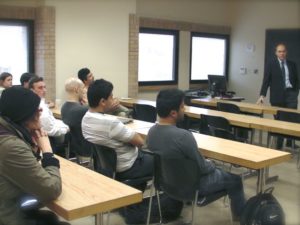
Acoustics Seminars are usually held on Fridays during the long semesters.
EE/ME 397K-1: Acoustics Seminar. Offered every fall and spring semester.
Acoustics-Related Courses in
Cockrell School of Engineering
These courses either include coverage of some aspect of acoustics or are on topics that are closely related to acoustics and its applications.
Biomedical Engineering
BME 381J-3: Biomedical Imaging: Signals and Systems. Physical principles and signal processing techniques used in thermographic, ultrasonic, and radiographic imaging, including image reconstruction from projections such as CT scanning, MRI, and millimeter wave determination of temperature profiles.
BME 381J-5: Therapeutic Heating. Engineering aspects of electromagnetic fields that have therapeutic applications: diathermy (short wave, microwave, and ultrasound), electrosurgery (thermal damage processes), stimulation of excitable tissue, and electrical safety.
BME 381J-7: Digital Image and Video Processing. Digital image acquisition, processing, and analysis; algebraic and geometric image transformations; two-dimensional Fourier analysis; image filtering and coding.
BME 384J-1: Biomedical Instrumentation I. Application of electrical engineering techniques to analysis and instrumentation in biological sciences: pressure, flow, temperature measurement; bioelectrical signals; pacemakers; ultrasonics; electrical safety; electrotherapeutics.
BME 384J-2: Biomedical Instrumentation II: Real-Time Computer-Based Systems. Design, testing, patient safety, electrical noise, biomedical measurement transducers, therapeutics, instrumentation electronics, microcomputer interfaces, and embedded systems.
Civil Engineering
CE 381W: Introduction to Wave Physics. An introductory course in the theory and modeling of propagating waves, primarily elastic waves. Subjects may include scalar waves in 1-D and 2-D, traveling and standing waves, flexural waves in beams, dispersion, phase and group velocity, vector waves in 2-D and 3-D, waves in infinite media and semi-infinite media, P waves, SH waves, SV waves, Rayleigh and Love surface waves, Stoneley waves, reflection and transmission at interfaces, numerical modeling, radiation conditions, scattering and radiation from obstacles, and fluid-solid interaction.
CE 387R-2: Soil and Rock Dynamics. Wave propagation in soil and rock, foundation vibration and isolation, dynamic behavior of soil.
CE 387R-5: Geotechnical Earthquake Engineering. Application of soil dynamics to earthquake engineering; influence of soil conditions on ground motion characteristics; evaluation of site response using wave propagation techniques; liquefaction of soils; liquefaction mitigation; seismic response of earth structures; seismic slope stability.
CE 394-1: Dynamic Soil-Structure Interaction. Fundamentals of wave propagation; determination of foundation stiffnesses; mat foundations on the surface of a layered soil; embedded foundations; pile foundations; effect of foundation conditions on dynamic response of structures to applied loads (machine foundations) and to seismic excitation.
CE 397: NDT Techniques in Civil Engineering. Basic signal processing knowledge; introduction to wave propagation theory; NDT principles and applications to steel structures; evaluation of concrete structures and foundations using stress waves and electromagnetic waves; NDT methods selection; emerging technologies.
Engineering Mechanics
EM 394V: Wave Propagation. Transverse waves in strings, waves in membranes, longitudinal waves in rods, nonlinear stress-strain, waves in Bernoulli-Euler beam, general linear elastodynamics.
Mechanical Engineering
ME 383Q-1: Vibrations. Formulation of discrete and continuous models for mechanical systems in vibration; modal analysis; analytical solution methods for constant property linear systems; numerical solution methods.
ME 383Q-5: Wave Propagation. Fundamentals of wave propagation; transverse waves on strings and membranes; compressional, torsional, and flexural waves in rods and plates; longitudinal, shear, and surface waves in elastic media; tube waves; and water waves. This course has effectively been replaced by CE 381W, Introduction to Wave Physics, listed under Core Acoustics Courses in Engineering.
ME 383Q-8: Digital Signal Processing. Sampling and quantizing processes; analog/digital and digital/analog conversion; digital Fourier analysis, including fast Fourier transform; z transform; design of finite impulse response and infinite impulse response digital filters.
Petroleum and Geosystems Engineering
PGE 381K: Engineering Analysis. Application of classical methods of mathematical analysis to problems frequently encountered in engineering applications. Acoustics students in engineering frequently take this introductory course in applied mathematics.
Seismo-Acoustics Courses in
Jackson School of Geosciences
Geological Sciences
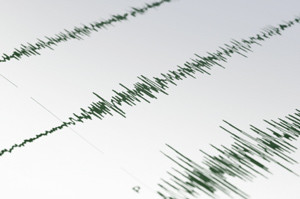
Seismogram
GEO 384C: Seismology I. Seismic, gravity, magnetic, electrical, and electromagnetic methods of exploration for petroleum and minerals.
GEO 380F: Seismology II. Basic seismology theory and its application to the study of the interior of the Earth (crust, mantle, and core), earthquakes, and plate tectonics.
GEO 390D: Seismology III. Advanced treatment of elastic wave propagation in heterogeneous anisotropic media, vectors and tensors, Christoffel equation, group and phase velocities, invariant embedding (reflectivity), finite difference, finite elements, and spectral elements.
GEO 380N: Sequence Stratigraphy. Use of seismic reflection systems for quantitative stratigraphic characterization of the subsurface.
GEO 384D: Physics of Earth. Geophysics of the whole Earth: seismic methods of inferring Earth structure, chemical makeup of Earth, tides and rotational variations, geomagnetism, heat flow, earthquakes, and seismicity.
GEO 384E: Seismic Migration and Inversion. Use of the acoustic or elastic wave equation to construct subsurface images in seismic processing. Different methods of solution and data domains employed in routine applications. Investigates integral, implicit, and explicit finite differences and Fourier methods for the imaging and inversion of seismic reflection data.
GEO 384T: Seismic Lithology. How seismic waves propagating through earth materials respond to relevant rock, reservoir, and fluid properties in the subsurface, and how seismic data recorded on the surface are used to describe, discriminate, and estimate these rock, reservoir, and fluid properties in the subsurface.
GEO 384U: Quantitative Seismic Interpretation. Seismic inversion, a tool for reservoir characterization, post- and pre-stack modeling, rock physics and fluid replacement modeling, wavelet estimation and post-stack inversion, AVO and pre-stack inversion, multi-attribute regression and neural network, and net pay estimation. Extensive hands-on training with three-dimensional seismic and well-log data.
GEO 384W: Seismic Imaging. Seismic reflection imaging for visualizing the interior of Earth’s upper crust. Study of fundamental imaging concepts from a unified geometrical point of view. Hands-on practical experience with imaging seismic data in an open-source software environment.
Hearing and Speech Science Courses in
College of Communication
Communication Sciences and Disorders
For the most current listing of these courses, see Audiology Graduate Courses.
CSD 393E-8: Anatomy and Physiology of the Speech and Hearing Mechanism. In-depth study of the anatomy and physiology of structures involved in speech, language, hearing, and swallowing. Includes anatomical and physiological mechanisms of respiration, phonation, articulation and hearing; and the central nervous system and blood supply to the speech and hearing mechanism.
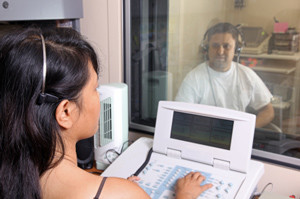
Student giving a hearing exam.
CSD 394C: Amplifying Systems in Aural Rehabilitation. Principles of hearing aid circuitry and looped systems; ear molds and acoustic properties thereof; electroacoustic properties of hearing aids and selection procedures.
CSD 394D: Hearing Conservation. Auditory and nonauditory effects of noise; damage-risk criteria; federal and state laws governing noise and noise control; acoustic measurement procedures; identification audiometry; ear protection; nonorganic hearing loss and evaluative procedures.
CSD 394E: Auditory Electrophysiology. Review of the auditory nervous system; in-depth evaluation of electrodermal, electroencephalographic, and electrocardiographic audiometry.
CSD 394F: Medical Audiology. Audiologic implications of pathology and medical and/or surgical treatment of the ear; otologic diagnoses.
CSD 395: Pediatric Audiology. Current methods of testing the hearing of young children; included are identification, electrophysiological and operant audiometry, and medical aspects of hearing loss in children.
CSD 396C: Advanced Amplifying Systems. Fitting of advanced amplification systems, including digital hearing aids, frequency modulation and other wireless systems, and assistive listening devices.
CSD 396E: Advanced Auditory Electrophysiology. Advanced diagnostic tools, including acoustic immittance, otoacoustic emissions, auditory evoked potentials, intraoperative monitoring, and vestibular function.
CSD 396G: Surgically Implanted Auditory Prostheses. Determining candidacy for treatment, programming devices, and evaluating treatment outcomes associated with implantable hearing technologies.
CSD 396M: Instrumentation in Communication Sciences. Electrophysiological and electroacoustic procedures in the study of communication behaviors.
Electronic Music Courses in College of Fine Arts
Music
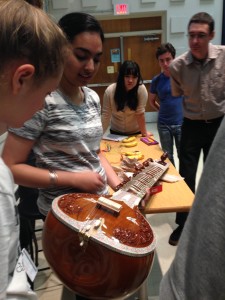
Student project in Musical Acoustics, analyzing a sitar.
MUS 329E: Introduction to Electronic Media (Undergraduate). Introduction to the fundamentals of recording, tape editing, and electronic music synthesis. One and one-half lecture hours and eight laboratory hours a week for one semester.
MUS 329F: Projects in Electronic Media (Undergraduate). Independent studies and private instruction in electroacoustic composition.
MUS 329G: Intermediate Electronic Composition (Undergraduate). Continuation of MUS 329E for music theory or composition majors. One and one-half lecture hours and eight laboratory hours a week for one semester.
MUS 329J: Introduction to Computer Music (Undergraduate). An introduction to the basic concepts of digital music synthesis and signal processing. One and one-half lecture hours and eight laboratory hours a week for one semester.
MUS 329M-1: Intermediate Computer Music (Undergraduate). Advanced Csound or Max/MSP/Jitter (a continuation of MUS329J). One and one-half lecture hours and eight laboratory hours a week for one semester.
MUS 329M-2: Intermediate Computer Music (Undergraduate). Introduction to interactive music and algorithmic composition with MAX/MSP. One and one-half lecture hours and eight laboratory hours a week for one semester.